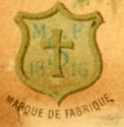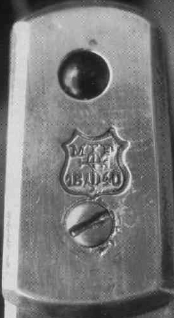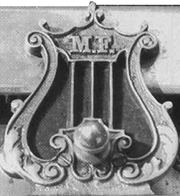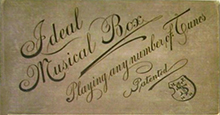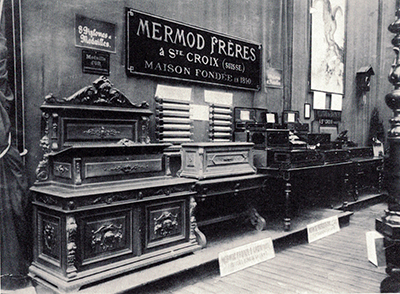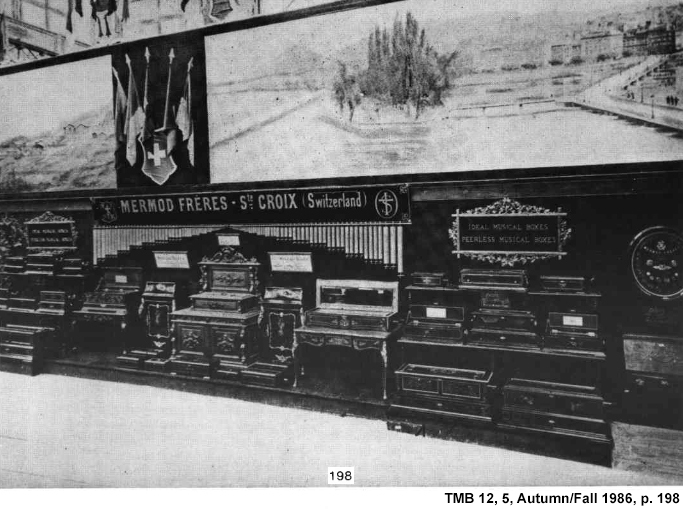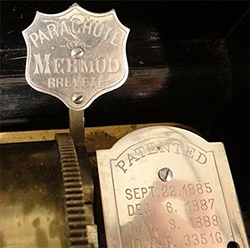|
The MERMODS Mermod Frères (MF),
The Mermods in chronological order Louis Mermod (?–?, founder in 1814) (first generation) François Mermod (?–?, first oder second generation?) Philippe Mermod 1867: Charles, Edouard, Gustave, Louis-Philippe, Edmond, Alfred and Léon (third generation) Louis-Philippe Mermod (1847–1926) Adrien and Marc Mermod (1896–1911) (fourth generation) William Mermod (1911–1925) (fifth generation) Mermod et Bornand (1884–1893) Léon Bornand (1893–?) The Mermods in alphabetical order Adrien Mermod (1896–1911, fourth generation) Alfred Mermod (third generation) Charles Mermod (third generation) François Mermod (?–?, first oder second generation?) Gustave Mermod (third generation), Gustave Mermod in Vienna (1900–1903) Léon Mermod (third generation) Louis Mermod (?–?, founder in 1814, first generation) Louis-Philippe Mermod (third generation) = Louis-Philippe Mermod (1847–1926) Marc Mermod (1896–1911, fourth generation) Philippe Mermod William Mermod (1911–1925, fifth generation) Zu den Datierungen der Seriennummern der Spieldosen Die Firma Mermod / Mermod Fères bestand (durch die Übernahme einer 1816 gegründeten Spielwerkfirma) von Beispiele für Firmensignets
Nrn. 13985; 60576, und 73973 (zweifach)
Nr. 70681 und unnummeriertes Spielwerk in einem Fotoalbum Nrn. 41564 und 117977
©TMB 17, 1, 1995
Die meisten der mehr vermutlich als 100.000 (!) Spielwerke Und wenn sich bei den interchangeables die Musiktafeln auf der Innenseite des Deckels keinen Platz mehr fanden, wurden sie lose einem Heftumschlag beigelegt
Mermod bei der Weltausstellung im London im Jahr 1851 gewinnt Anerkennungen ... für seine hochwertigen Taschenuhren (!)
Bulleid, Musical Box Tune Sheet 3rd Supplement S. 56
Links: Philippe Mermod, 1812–1895 (Chapuis, Alfred, Abb. 177, S. 194) 1816: Louis Mermod founded the company with in a partnership with three brothers, Costs of a musical snuffbox with a horn cover Louis Mermod, merchant of lace and of music boxes 1831: François Mermod was made head of the company 1840: usual criteria for the constitution of a company 1816 until mit 1840s: lace and grocer trade became less important and was progressively replaced by music boxes without giving up watches 1867: Charles, Edouard, Gustave, Louis-Philippe, Edmond, Alfred and Léon Mermod Mermod Frères at Exhibitions Stand bei der Ausstellung in Antwerpen im Jahr 1885
Weltausstellung in Mailand 1906 Hermann Thorens' report about the exhibition explained the rapid evolution of the sound reproduction instrument market and the way the three most important manufacturers of Sainte-Croix – Paillard, Mermod Frères and Thorens – adapted themselves to the market. (Le Pays horloger).” (Piguet 2004, p. 297-306) Best trade connections in many parts of the world Thanks to its longstanding relations with traders in Couvet and Fleurier, they opened the Chinese market to music boxes, and this ensured that during off-peak periods, they manufactured large quantities of snuffboxes with Chinese tunes. Jules Jaques, established in Vienna 1865–1875: Jules Jaques See the Austrian chapter Jules Jaques 1875-?: Louis-Philippe Mermod In the United States, it was first Emile L. Cuendet who represented the company, in cooperation with C. H. Jacot, and they had the exclusive distribution rights of the Mermod products which were sold in music shops and l in most of the urban areas. They occupied the sector of music boxes of excellent quality at relatively popular prices, as opposed to novelties or small musical movements incorporated in toys, souvenirs and other objects. The first research and development department Gustave Mermod, first in his own name, and then the company engineers on the company´s behalf, were the authors of innumerable developments. Among the better known inventors, there was Charles-Henri Jacot, who was one of the precursors of the parachute (the safety check device which prevented music box springs from suddenly uncoiling), and then his sons, who set up the Jacot & Fils agency in New York. Let us not forget Alexandre Vernaz whose contribution was in the disc box sector. Parachute
The company was the first to set up a technical department, in charge of the research and development. They recruited the best engineers on the market at the time and tried to exploit their development to advantage. Up to that time, the mechanics, through direct contact with metal and machines, through experience and spontaneous exchange, had been the main initiators of developments made in tool design and music box production. However, the absece of federal law on patents up until 1888 gave no clear indication of this progress. At the end of the nineteenth century, Mermod had the means to channel this technique, to capture the ideas expressed in the workshops while absolving the shopmasters from drafting the new parts or tools themselves. With Paillard and Thorens on the scene, competition was fierce. They fought for the best workers and tried to be the first to find new techniques and new products. Ambassadors of music boxes In 1867, Philippe Mermod, together with Félix Cuendet and J. Mabile, signed a report to the State Council on industrial activity in Sainte-Croix and also drew up statistics on salaries in 1873. His son Louis-Philippe was particularly active and tenaciously defended the interests of the company and of the major manufacturers in general. In 1884, he did not seem preoccupied by the drop in sales prices of music boxes, “in spite of this reduction, our people are less unhappy than those who live in the villages which only have a watchmaking industry”, but on the other hand he very much wanted steps to be taken to improve apprenticeship training: “Work ist not based on any theory, whatever constitutes music box manufacture is done empirically, and the SIC will have earned the gratitude of Sainte-Croix if it succeeds in doing something to improve production.” (SIC Minutes 267-270) Two years later [in 1886], the situation in the music box industry showed signs that confirmed the downward trend. Louis-Philippe Mermod accepted to chair a SIC commission [in 1886] to investigate the problem and to work out solutions. His report [...] concluded that “it contains serious information for the music box industry. A large German manufacturer is looking for workers, specifically for comb production, and intends to be a more formidable competitor for the Swiss music boxes than any to date.” (SIC Minutes 267-270) The advent of the German disc-playing boxes, whose tunes were reproduced in enourmous quantities, encouraged composers to try once again to obtain copyright payments on mechanical reproduction. However, they came up against fierce opposition on the part of the Sainte-Croix music box manufacturers, led by Louis-Philippe Mermod, who wrote a wonderful plea in order to convince the Federal Council that it was inadequate, useless and unrealistic to think of claiming copyright on music boxes … “Our industry would be dealt a fatal and irreparable blow if copyright were imposed on punched cards and pinned cylinders made in Europe. European manufacturers would have no other alternative but to go and settle in the United States to benefit from the advantages granted for sound reproduction. This would mean emigration to America for our industry, and the beginning of the end for manufacturers and workers in Switzerland.” (SIC archives, copy of letters 157) The coypright question came up again in 1912, more threatening than before, and it was Louis-Philippe Mermod who was once again delegated to defend the interests of the manufacturers, a task he carried out with consummate art and commitment. He travelled to the Conference in Bern on 20th May and wrote a report, giving a perfect description of the music box, a definition which has become necessary because of the draft law on coyprights and the attempt to obtain exemption for music boxes. Here it is: “It is an instrument in which steel teeth are put into vibration by means of levers, pins or gears.” (SIC minutes 388) The copyright question would come up again in 1913 and then be forgotten for the duration of the war. Social relations On 2nd March 1889, on the occasion of a reception at the Hôtel du Jura given by Ami Mermod, the company invited its sixty workers to an annual dinner, followed by “various productions, speeches, orations and songs which succeeded one another well into the night, alternating with the music from the not exactly Sublime Harmonie of our great German adversary, the Phoénix, cousin to the Ariston”. (FAS 9th March 1889) Among the speeches, one stood out, the one which gave an explanation of the new profit sharing system. “After two years of employment, are entitled to share in the profits all workers or staff members working exclusively for the company; the definition of the amount takes into account two factors: the length of service for the company and services rendered commensurate with salary. Participation is increased after 5 years and again after 10 years of employment. Annual profit shares are paid into the Deposit Account of the person concerned and yield an interest of 4% per annum. The capital is paid out to the worker or his family upon leaving the company; interest is paid annually …” […] Nevertheless, in its relations with the working world, Mermod Frères was not precisely open to negotiation and was even in open conflict in 1920 when the economic situation was particularly tense. Like the other manufacturers, the company tried to get past the reductions in working time imposed by the new federal legislation of 1917. They even drew up a petition which they tried to get the workshops to sign, in order to prove that the workers themselves did not want the proposed changes. The manouever failed but it revealed a certain paternalism which was widespread at the time and which advocated that workers could only be grateful to their bosses for giving them work and the means to live. The first factories The transition from manual production to industrialization called for the construction of large factories 1857–1881: at Philippe and François´ place, 1881 in the Rue de l´Industrie in and with Louis-Philippe after 1882 In 1885–1898: Three factories, it built its first factory in the Avenue des Alpes, followed by a second in 1983 and a third in 1898 The two main buildings (inscribed Mermod Frères, boȋtes à musique up to about 1980) had four floors which, connected by a passageway, formed a surface area of about 5,000 square meters, for offices and workshops. Lean gas was produced in an annex and fed a twenty-five HP motor capable of supplying all the energy needed for company operation: steel hardening and cement melting for the cylinders, all the transmissions, the water-tank pump situated in the attic for staff needs, as well as heating. The current also drove a dynamo supplying electric light for the factory at night and energy for electro- and nickelplating during the day. Visit of the factory in 1896 “The other manufacturing stages, divided into numerous workshops or separate chambers, serve for the musical part in itself; the cylinders, once swivelled, turned and polished, are passed to the marker-musicians who read the music specially arranged for each type of component; there are hundreds of models and formats, from the 8-note to the 180-note movement, as the Mermod Frères musical library contains thousands of handwritten tunes. The markers write the notes on the cylinder with special tools. A certain small cylinder playing a tune with eight notes will take a quarter of an hour to be marked with the fifty notes composing its unique melody, another of larger dimensions will take eight days of intensive work by an expert marker to be covered with the 35,000 points representing the eigth tuned it has to play …” “The finished movement is assembled in a box and the packed and in a short while it will be rolling in the direction of the capitals and the ports of europe, from where it will transit across the seas to decorate and to brigthen up not only the farmer´s cottage but also the nabob´s mansion and the palaces of the kings of finance.” (The Watchmaking Country, pp. 32-36) Music boxes of prestige For half a century, Mermod Frères was the most technically advanced of music box manufacturers: the company constantly improved the cylinder boxes, making veritable orchestras of the highest sound quality. It was also the first to face up to the German disc-playing box manufacturers, offering all possible combinations imaginable in its attempt to resist pressure from the gramophones. In the 1880s, Mermod Frère took over the cylinder change process invented by Amédée Paillard and simplified it to make it more comfortable to use: cylinders were removed and replaced manually, the levers functioning automatically. In addition, the cylinders were interchangeable not only on the same box, but on all other boxes of the same type, which was a distinct advantage over the other manufacturers whose rechangeable cylinders were only adapted to the precise box for which they had been designed. One could therefore buy an Ideal Sublime Harmonie from Mermod and order more cylinders for it later on. Moreover, the company was more than happy to provide a cabinet with sliding drawers to store the spare cylinders. This principle, like that of the parachute, was applied to the Peerless range (inexpensive boxes, with one single comb) and Ideal, which came with multiple adjustments, from the simplest to the Ideal Orchestra, which represented a synthesis of music box sound and the depth of the celestial voices of the organ and its bell, drum and castanet effects. These articles played an unlimited number of tunes by means of interchangeable cylinders, forever repeatable. Their repertoire consisted largely of operatic extracts. At the Exposition Nationale in Geneva in 1896, Mermod Frères occupied a major part of the showroom devoted to the Sainte-Croix music box manufacturers. They also took part in a Swiss village, in the chalet from Saanen, where one could audition musical automata and watch the patient annotation and verification of a tune on the cylinder of an Ideal box, carried out by workers from the Jurassian factory. Ideal Sublime Harmonie At the beginning of the 20th century, in spite of the remarkable efforts made by Swiss manufacturers of cylinder and disc boxes, enhanced with all possible combinations to facilitate their use, offering the largest possible tune range, at ever lower prices; in spite of all this, competiton from mechanical pianos and especially phonographs, became ever more pressing and the decline of the large music box ever more obvious. 1904: Diversification 1896: Adrien and Marc Mermod The fifth generation was integrated in 1911 with William, who succeeded Gustave-Alfred Mermod. On 29th August 1910, the company modified its statutes to become a limited company with a capital of one million francs. The Board included Louis-Philippe, Gustave-Alfred and Léon-Marcel Mermod, as well as Constant Jaccard-Addor and Jules Diserens. On the brink of the 1920s, Mermod Frères SA, still managed in a collegial manner by members of the family, experienced a number of internal and external problems which prompted the management to start negotiations with other manufacturers. Opposite the Mermod Factories, on the other side of the Avenue des Alpes, Hermann Thorens had erected several buildings for the purpose of producing music boxes and subsequently gramophones. Both families knew one another well, belonged to the same social circles and shared the same philosophy in many respects. On 3rd November 1924, the statutes of the company were modified and henceforth limited to activty in the “the mechanical sector, manufacturing, transformation and trade in all metals” (Trade Register), and the capital was reduced to 325,000 francs. The name Mermod Frères disappeared from the Trade Register on 24th May 1927, after its transfer. 1st February 1925: Mermod Frères taken over by Hermann Thorens, producing gramophones Special machines, unique in the world, for the production of large music boxes, where destructed. This was the end of died Mermod Frères, which had been one of the most brilliant companies in the world in the watch and music box sector, and which had contributed for over a century to the prosperity of trade and industry in Sainte-Croix. Mermod et Bornand, 1884–1893 This firm was one of the very few makers of music boxes Justin Bornand bequeathed to his son Léon his know-how and no doubt his love of music boxes. On 1st October 1884, Léon Bornand teamed up with Georges Mermod junior, under the name of Mermod et Bornand, to make all types of music boxes. The following year, they went to the Exposition universelle in Antwerp, together with Mermod Frères, in order to defend the colors of Sainte-Croix. In cooperation with Georges Perrier they designed and patented improvements and, more particularly, manufactured themselves as successors to Arthur Jeanrenaud. The company employed four workers in 1888 and was considered one of the fifteen most important music box manufacturers in Sainte-Croix. All activities ceased in 1893. (Piguet 2004, p. 264-274) Léon Bornand, 1893–? Mermod-Jaccard
The connections of Mermod Frères to VIENNA 1.) See Jules Jaques 2.) See Gustave Mermod, established in Vienna 1900–1903 3.) Österreich als Exportland für Mermod Frères Was die Musikprogramme betrifft, sind besonders zwei österreichische Komponisten wichtig, für die Mermod Frères viel getan hat, sicherlich mehr als die österreichischen Komponisten Resch und Genée. Bellamy, Music Makers of Switzerland, (2015), p. 6; Piguet 2004, p. 264-274
|








